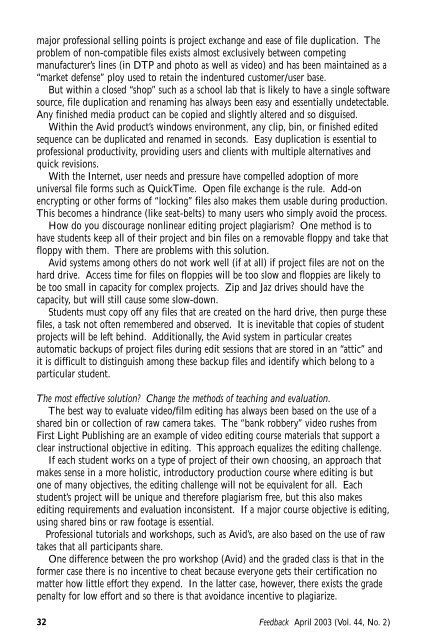APRILFeedback
Feedback April 2003 (Vol. 44, No. 2) - Broadcast Education ...
Feedback April 2003 (Vol. 44, No. 2) - Broadcast Education ...
- No tags were found...
Create successful ePaper yourself
Turn your PDF publications into a flip-book with our unique Google optimized e-Paper software.
major professional selling points is project exchange and ease of file duplication. Theproblem of non-compatible files exists almost exclusively between competingmanufacturer’s lines (in DTP and photo as well as video) and has been maintained as a“market defense” ploy used to retain the indentured customer/user base.But within a closed “shop” such as a school lab that is likely to have a single softwaresource, file duplication and renaming has always been easy and essentially undetectable.Any finished media product can be copied and slightly altered and so disguised.Within the Avid product’s windows environment, any clip, bin, or finished editedsequence can be duplicated and renamed in seconds. Easy duplication is essential toprofessional productivity, providing users and clients with multiple alternatives andquick revisions.With the Internet, user needs and pressure have compelled adoption of moreuniversal file forms such as QuickTime. Open file exchange is the rule. Add-onencrypting or other forms of “locking” files also makes them usable during production.This becomes a hindrance (like seat-belts) to many users who simply avoid the process.How do you discourage nonlinear editing project plagiarism? One method is tohave students keep all of their project and bin files on a removable floppy and take thatfloppy with them. There are problems with this solution.Avid systems among others do not work well (if at all) if project files are not on thehard drive. Access time for files on floppies will be too slow and floppies are likely tobe too small in capacity for complex projects. Zip and Jaz drives should have thecapacity, but will still cause some slow-down.Students must copy off any files that are created on the hard drive, then purge thesefiles, a task not often remembered and observed. It is inevitable that copies of studentprojects will be left behind. Additionally, the Avid system in particular createsautomatic backups of project files during edit sessions that are stored in an “attic” andit is difficult to distinguish among these backup files and identify which belong to aparticular student.The most effective solution? Change the methods of teaching and evaluation.The best way to evaluate video/film editing has always been based on the use of ashared bin or collection of raw camera takes. The “bank robbery” video rushes fromFirst Light Publishing are an example of video editing course materials that support aclear instructional objective in editing. This approach equalizes the editing challenge.If each student works on a type of project of their own choosing, an approach thatmakes sense in a more holistic, introductory production course where editing is butone of many objectives, the editing challenge will not be equivalent for all. Eachstudent’s project will be unique and therefore plagiarism free, but this also makesediting requirements and evaluation inconsistent. If a major course objective is editing,using shared bins or raw footage is essential.Professional tutorials and workshops, such as Avid’s, are also based on the use of rawtakes that all participants share.One difference between the pro workshop (Avid) and the graded class is that in theformer case there is no incentive to cheat because everyone gets their certification nomatter how little effort they expend. In the latter case, however, there exists the gradepenalty for low effort and so there is that avoidance incentive to plagiarize.32Feedback April 2003 (Vol. 44, No. 2)
















